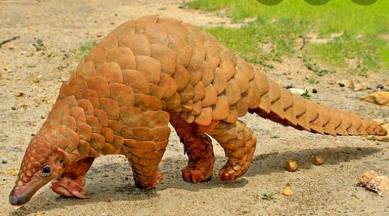Stay updated with the latest - Click here to follow us on Instagram
Over 1,200 pangolins poached, trafficked in India during 2018-22: Report
Pangolins are poached mainly for international markets in China and Southeast Asia for their scales, which are used as an ingredient in traditional medicines and are believed to cure various ailments.

Over 1,200 pangolins, also known as the scaly anteaters, were poached and trafficked in India over the past four years from 2018 to 2022, according to a recent report released jointly by the World Wide Fund for Nature India also called WWF India, and TRAFFIC, a non-governmental organisation which monitors illicit global wildlife trade.
The report says that 1,203 pangolins (both live and dead) were seized in 342 incidents and that the actual numbers of the animal being trafficked are likely to be far higher. Over 880 kg of pangolin derivatives and 199 live pangolins were reported in the 342 seizure incidents.
monthly limit of free stories.
with an Express account.
Pangolins are reported to be among the most trafficked wild mammals globally.
“India reports a significant number of pangolin trafficking incidents. They are poached mainly for international markets in China and Southeast Asia for their scales, which are used as an ingredient in traditional medicines and are believed to cure various ailments. Pangolin meat is also considered a delicacy and consumed for alleged medicinal properties,” said Dr Merwyn Fernandes, coordinator of TRAFFIC’s India Office, said.
An earlier analysis by TRAFFIC released in 2018 found poaching of nearly 6,000 pangolins between 2009 and 2017. Last year, TRAFFIC found that India recorded the highest number of pangolin seizures in Asia between 2015 and 2021 at 287 seizures. The Directorate of Revenue Intelligence (DRI) was reported to have seized 336.9 kg of pangolin scales between 2019 and 2022.
Twenty-four states and one Union Territory reported seizures of pangolins and their derivatives. In its latest analysis, WWF-TRAFFIC found that the maximum number of pangolins was seized in Odisha – 154 pangolins in 74 seizures.
Live pangolins and their derivatives such as scales, carcasses, skins, claws, meat, bones, and other body parts were confiscated during 2018-2022. Live pangolins constituted 50 per cent of the seized items and accounted for 199 animals.
The maximum number of live pangolins were caught from Odisha (45 incidents and 50 pangolins), followed by Maharashtra (27 incidents and 32 pangolins).
Pangolins belong to the family Manidae and in India, they are the only known mammals with large keratin scales covering their skin. They are toothless, nocturnal, live in burrows, and feed mainly on ants and termites.
Globally there are eight pangolin species, four each in Africa and Asia. India is home to two species – Indian pangolin Manis crassicaudata and Chinese pangolin Manis pentadactyla. Indian pangolins are found in Bangladesh, India, Nepal, Pakistan, and Sri Lanka. In India, the species is widely distributed and has
been recorded in Andhra Pradesh, Assam, Bihar, Chhattisgarh, Goa, Gujarat, Jharkhand, Karnataka, Madhya Pradesh, Maharashtra, Meghalaya, Odisha, Rajasthan, Tamil Nadu, Uttarakhand, Uttar Pradesh, and West Bengal.
Chinese pangolins are found in Bangladesh, Bhutan, China, Hong Kong, India, Lao People’s Democratic Republic, Myanmar, Nepal, Taiwan, China, Thailand, and Vietnam. In India, the species is reported from Arunachal Pradesh, Assam, Bihar, Manipur, Meghalaya, Mizoram, Nagaland, Sikkim, Tripura, and West Bengal.
“Both pangolin species, the Indian and Chinese varieties, continue to be found in illicit trade despite having legal protection. The number of pangolin seizure incidents is a cause of concern for the survival of this elusive species, for which there is limited information on population status and distribution. There is an imperative need to focus on pangolins, strengthen their protection and conservation for their future survival,” said WWF India CEO Ravi Singh.
Pangolins, which act as both predators and prey, have a huge ecological significance, experts say. They feed on insects and help regulate their population.
Pangolins are “ecosystem engineers” that build burrows that help circulate soil organic matter, increase soil moisture and aeration, and affect plant community succession through their burying behaviour. The burrows made by pangolins also get utilised as shelters by other species within their ecosystem. Over 30 species have been reported to use the burrows made by Chinese pangolins, including mammals, birds, reptiles, and invertebrates, for different purposes.
In India, both Indian pangolins and Chinese pangolins are listed in Schedule I of the Wildlife (Protection) Act, of 1972. Therefore hunting, trade, or any other form of utilisation of the species or their body parts and derivatives is banned. Since 2017, all pangolin species have been listed in Appendix I of the Convention on International Trade in Endangered Species (CITES), prohibiting their commercial trade